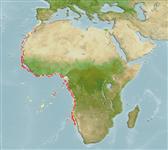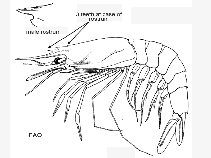Aristeus varidens Holthuis, 1952
Striped red shrimp| Native range | All suitable habitat | Point map | Year 2050 |

|
| This map was computer-generated and has not yet been reviewed. |
| Aristeus varidens AquaMaps Data sources: GBIF OBIS |
Classification / Names Common names | Synonyms | CoL | ITIS | WoRMS
Malacostraca | Decapoda | Aristeidae
Environment: milieu / climate zone / depth range / distribution range Ecology
Benthic; depth range 300 - 1134 m (Ref. 8), usually 400 - 600 m (Ref. 8). Tropical, preferred 26°C (Ref. 107945); 36°N - 24°S, 18°W - 14°E
Distribution Countries | FAO areas | Ecosystems | Occurrences | Introductions
Eastern Atlantic: Morocco to Namibia.
Length at first maturity / Size / Weight / Age
Maturity: Lm ? range ? - ? cm Max length : 12.0 cm TL male/unsexed; (Ref. 434); 20 cm TL (female)
Demersal (Ref. 106863). Occurs at depths of 300 to 1134 m, common at depths of 400 to 600 m, usually on bottom mud in subtropical and tropical environments (Ref. 8). On the continental shelf and slope down to 800 m (Ref. 106863). Feeds on crustaceans, fishes and polychaete worms (Ref. 434).
Life cycle and mating behavior Maturity | Reproduction | Spawning | Eggs | Fecundity | Larvae
Members of the order Decapoda are mostly gonochoric. Mating behavior: Precopulatory courtship ritual is common (through olfactory and tactile cues); usually indirect sperm transfer.
Main reference
References | Coordinator | Collaborators
Holthuis, L.B. 1980. (Ref. 8)
IUCN Red List Status (Ref. 130435)
CITES status (Ref. 108899)
Not Evaluated
CMS (Ref. 116361)
Not Evaluated
Threat to humans
Human uses
Fisheries: commercial
FAO - Fisheries: landings | FishSource | Sea Around Us
Tools
More information
Internet sources
BHL | BOLD Systems | CISTI | DiscoverLife | FAO(Fisheries: ; publication : search) | Fishipedia | GenBank (genome, nucleotide) | GloBI | Gomexsi | Google Books | Google Scholar | Google | PubMed | Tree of Life | Wikipedia (Go, Search) | Zoological Record
Estimates based on models
Preferred temperature
(Ref. 115969): 3.6 - 5.1, mean 4.4 (based on 34 cells).
Nutrients: Calcium = 109 [35, 184] mg/100g; Iron = 1.59 [1.21, 1.97] mg/100g; Protein = 20.2 [19.2, 21.3] %; Omega3 = 0.285 [0.185, 0.386] g/100g; Selenium = 48.3 [-31.7, 128.3] μg/100g; VitaminA = 0 μg/100g; Zinc = 1.79 [1.17, 2.40] mg/100g (wet weight).



